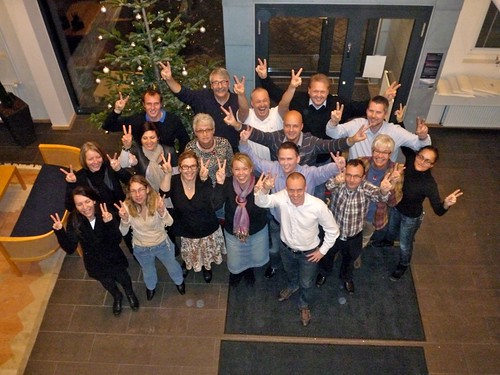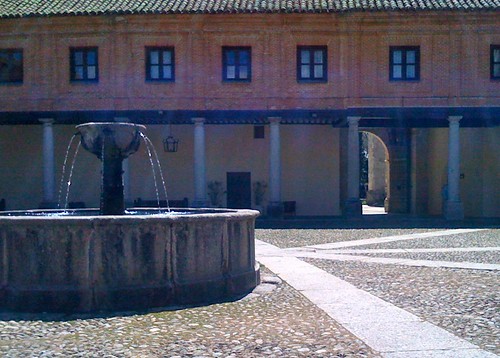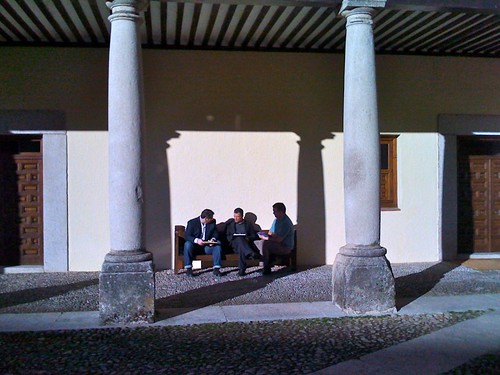We wrapped up this year with a great After Action Review for Berendsen Textil. The final workshop in their 12 week GROW Leadership program. I shall look forward to continuing working with Berendsen in the coming year they are a great bunch of lovely people with a passion for what they do!
Training & Development
Join us for the ALIA Europe programme
In less than two months the ALIA Europe programme will be in full swing.
I am looking forward to being among the 100+ learners convening around authentic leadership in action. It will be a programme rich in design, and also in the diversity and life experience of the people in attendance. Participants are coming from Australia, Belgium, Canada, Denmark, France, Germany, Ireland, Netherlands, South Africa, Sweden, Switzerland, the United Kingdom, and the United States. This learning community, while coming face-to-face for a brief 6-day period, is part of a global movement of community and organizational leaders and followers striving for more effective, more humane living and working environments.
You can download the brochure here
“How can we improve learning in organizations?”
Jay Cross asks the question:
Here is Jay’s website with more on informal learning
Getting to grips with the Big Shift
[lang_en]For a while now I have been talking to friends and colleagues about this gut feeling that I have, that what we talk about as the economic crisis or downturn is possibly not a traditional crisis and/or downturn in the sense that once it is over things will return to normal.
I have this very clear feeling that a fundamental shift in many of the ways that we have been used to conducting business and interacting with each other is underway. (see also my previous post are you a frog in the pot) And that when the dust settles things will not return to what we have known previously as normal but will have undergone a clear shift. This is not a passing storm but fundamental climate change.
In pursuit of that theme I have been hunting for signs that would support this gut feeling.
This has led me to The 2009 Shift Index published by Deloite and presented on the Harvard publishing website.
Her you will find the following resume of key findings:
The 2009 Shift Index reveals a disquieting performance paradox in the US corporate sector. On the one hand, labor productivity has nearly doubled since 1965. During those same years, however, US companies’ Return on Assets (ROA) progressively dropped 75 percent from their 1965 level.
How can firms be getting lower returns even as they’re becoming more efficient? The answer resides in the heightened competition among firms. Competitive intensity nearly doubled between 1965 and 2008, forcing firms to compete away the benefits of productivity gains, which were instead captured by creative talent in the form of higher compensation and numbers of consumers through increasing performance/price ratios and wider choice.
It’s little surprise to find also that the highest-performing companies are struggling to maintain their ROA rates and are increasingly losing market leadership positions. Taken as a whole, the findings portray a U.S. corporate sector in which long-term forces of change are undercutting normal sources of economic value. “Normal” may in fact be a thing of the past: even after the economy resumes growing, companies’ returns will remain under pressure.
To respond to this performance challenge, U.S. companies will need to let go of industrial- era organizational structures (and the reporting relationships, incentive systems, and managerial processes that go with them) and operational practices in favor of the new institutional architectures and business practices needed to create and capture economic value in the era of the Big Shift.
Companies must move beyond their fixation on getting bigger and more cost-effective to make the institutional innovations necessary to accelerate performance improvement as they add participants to their ecosystems, expanding learning and innovation in collaboration curves and creation spaces. Companies must move, in other words, from scalable efficiency to scalable learning and performance. Only then will they make the most of our new era’s fast-moving digital infrastructure.
So what does this Big Shift entail in pratical terms?
John Hagel one of the co-authors of the 2009 Big Shift index does a superb job summarizing what he essentially sees as a shift from push to pull on his blog Edge Perspectives
What obviously caught my atention was this:
From knowledge transfer to knowledge creation
Most companies today will acknowledge the importance of knowledge flows, but they tend to focus on transferring knowledge more efficiently, especially within corporate boundaries. While useful, this is ultimately a diminishing returns game on multiple levels. The greatest economic value will come from finding ways to connecting relevant yet diverse people, both within the firm and outside it, to create new knowledge. They do this best by addressing challenging performance requirements that motivate them to get out of their comfort zone and come up with creative new approaches that generate more value with fewer resources.
This correlates well with the experiences that we have using action learning as our primary developmental tool in helping managers and organizations tackle the changes that they are in. It is not our job to teach but to help them learn – and that is a very different story.
But I urge you to read the full unfolding of this thinking here under the following headlines:
From knowledge stocks to knowledge flows.
From knowledge transfer to knowledge creation.
From explicit knowledge to tacit knowledge.
From transactions to relationships.
From zero sum to positive sum mindsets.
From push programs to pull platforms.
From stable environments to dynamic environments.
Lots of food for thought, and now I realize that my gut was telling me something important and I shall continue to pursue this investigation.[/lang_en]
Top 10 Meeting trends for 2009
Below is list of top 10 Meeting trends in the US as seen from the point of view of one of the big US operators. I think the overall trends very much reflect what I am hearing from the main European markets as well.
But I would also like to ad on a personal note that never has my in-box received so many offers of virtual seminars or webinars. From Harvard to grassroots organizations they are all jumping in to more and more advanced forms of elearning/brodcasting. At the same time I have been signed up to attend 3 major events/trainings/conferences this spring – they have all been canceled due to lack of attendants.
I am also getting very clear signs that clients are trying to not just reduce travel cost but to eliminate them completely. There is both a cost argument and an environmental consideration here – and i have a distinct feeling that this is not going to swing back to normal once the current financial difficulties are over. Once companies have learnt that no-travel is an option they are going to stick with that, swine flu is not going to help here either.
Trend 1 – The Business of Meetings is Business
This year more than ever before, the business of meetings is straight-up ROI. There’s not a lot of room for leisure and extracurricular play in the current meeting environment where every single dollar is measured for its contribution to the success of the overall conference.
Meetings have never been more serious, focused, or strategic — or more regional, for that matter, as transportation expenses are trimmed. It’s good news for conference centers, which are all about serious meeting environments.
Trend 2 – It’s Not Easy to be Green …
It’s not easy to be green … or at least it’s not easy to be green in a challenged economy! It isn’t that planners no longer care about the green status of a property – it’s just that they are a whole lot more focused at present on securing that property at the best price possible for their next meeting.
In 2009, price trumps green.
Trend 3 – We’ll Get Back to you in Six Months
Across Benchmark Hospitality’s portfolio, the first half of 2009 is proving to be a challenge with a lot of in-the-month-for-the-month meetings booked. Push-back on pricing is universal and meeting lengths are being shaved by a day, on average.
Things are looking up in the 2nd half of 2009 though. Booking pace is in recovery for the second half of the year and 2010 is on target and looking healthy.
Trend 4 – Stuffed, Packed, Studded with Value!
The demise of the complete meeting package is greatly exaggerated! For the most part, demand remains strong and the value of the package – and in Benchmark’s case the company’s branded Benchmark Conference Plan — is recognized. But packages are expected to be loaded with value, add-on benefits, and, get this, there’s a growing demand for double occupancy.
Although packages are negotiated with the usual rates, dates and space considerations, today’s negotiations linger on and on and on with planners watching every penny as meeting budgets are cut from 10 percent to slash & burn proportions. Every meeting dollar must be measurable and welcome receptions, afternoons of leisure, and special dinner events are out. Working lunches and dinners, regional gatherings, doubling up in guestrooms, and value-added options are what’s in this year!
Trend 5 – Believe It or Not, Teambuilding Remains!
Teambuilding is not D.O.A. this year as has been the case in other soft economies and demand is projected to increase in 2010.
Planners are negotiating hard on price, and fewer sessions are being scheduled this year over last, but companies continue to see value in the team-enrichment benefits offered through creative teambuilding programming, such as corporate social responsibility initiatives. In these exercises, groups are creatively brought together to accomplish a task as a team that also benefits a local or national charitable organization. Often the task is outside the norm of the group’s daily activities, and requires them to constructively pull together as a team to accomplish the assignment, frequently with new leadership patterns emerging.
Trend 6 – Tea for Two (make it herbal), Tee Times for Twenty
Maybe not this year. Tight budgets and serious meeting environments are taking their toll on extracurricular activities once so popular.
There’s no problem getting a spa or tee time this year, but it will be on the conferee’s own dime and it better not be scheduled over a conference session. Not that there’s anything wrong with a round of golf, a manicure or an herbal wrap, but in 2009 it’s about perception.
Trend 7 – I Plan, Therefore I Am
Once again the industry is consolidating. Planning is increasingly seen as a part-time function … with planning responsibilities loaded on already overwhelmed administrative personnel and department heads. And third party planners are re-emerging.
Conference Service Managers have never been more important or more welcome by this growing group of planners. Their one-stop planning resources and services, coupled with a purpose-designed learning environment, streamline the conference planning process, helping even the most inexperienced planner deliver a first-rate, productive meeting at a time when this is of maximum importance.
Trend 8 – Three Squares a Day. That’s it!
Gone are the welcome receptions, theme dinners and special luncheons. Planners’ meal requests are pretty much limited to three square meals a day and that’s it.
Companies are even asking that refreshment breaks be scaled back to downplay perceptions of extravagance. Where there are special requests by planners they’re about healthy options and fresh ingredients foraged locally.
Trend 9 – The Silver Lining
That’s right … there’s a silver lining and it’s found within select market segments where meeting demand is growing. These include government, military and defense-related meetings, as well as education, state associations and religious market gatherings. Perhaps this should make sense in these times.
There’s more. The medical, biotech and pharmaceutical segments remain strong too. Serious market segments for serious times, it seems – perfect for serious meeting environments.
Trend 10 – Getting Serious About Learning Environments
Productive meeting environments have never been more put to the test or proven their worth more actively than right now. In a business environment where every dollar – every penny for that matter — is meaningful and expected to yield a measurable ROI, dedicated meeting environments like conference centers deliver and planners are turning to them.
Ok, they may lack the glamour of center city hotels, or the status of landmark properties, or the sex-appeal of exotic resorts, but that’s a unique selling proposition these days.
Conference centers deliver on the promise of a dedicated and focused learning environment, are wired for maximum productivity, provide high quality yet non-extravagant food & beverage, offer pleasant and comfortable guestroom accommodations, and importantly, provide dedicated conference service support. In short, serious meeting environments for serious times.
Bron: Benchmark Hospitality International – 2009-04-25
Source : https://www.eventplanner.be/nieuws-trends/evenementen/3544/top-10-meeting-trends.html
What's your NPS score?
We have just completed a great workshop in Spain, just 100km outside Madrid in the Sierra de Guadarrama. The hotel Santa Maria de el Paular is adjacent to the monastery and and lends an air of tranquility to the whole place.
My role was to introduce a team of High Potentials on a talent development program in a (very) large production company to the ideas and thinking behind the Service Profit Chain. And once aging it becomes very clear to me that not just Hotels can befit from this approach. Virtually any business today is operating in a buyers market – there is to much of everything. And in this a situation of abundance there is no way that you will be able to advertise your way to better profits. Your message will drown in the noise. Instead you will need to rely on word of mouth – and that means that you need to generate enthusiastic customers that will spread the word…
As you can see below the setting was ideal and we had plenty of time for reflection and deep dialogue. What a pleasure.
We also managed to have a discussion on how the net promoter score works – you know the the ultimate and simples of all customer surveys where alle you ask your clients is: ” On a scale on one to 10 how likely is it that you would recomed our business to a friend or colleague.
Add up how many you have who scored 9 or 10 those are your promoters. forget those that scored you 7 or 8. Add up those that gave you between 1 and 6 – those are you detractors. Now deduct you detractors from your promotes and you have your net promoter index – simple and powerful.
What is a good score? Well 30 would be fine but the really customer centric companies can score in both the 60es and the 70es.
Try for your self – before it’s to late…
The setting and the hotel proved the ideal type of location for this type of work I hope to get a chance to go back before to long.

Talent kommer i mange forklædninger
[lang_da]Jeg ved ikke hvad i siger men jeg blev igen mindet om at folk ofte kan meget mere end man umildbart lige tror :
https://www.youtube.com/watch?v=9lp0IWv8Q
her er teksten Susan Boyle synger, som jo sætter det hele yderligere i perspektiv…
I dreamed a dream in time gone by
When hope was high,
And life worth living
I dreamed that love would never die
I dreamed that God would be forgiving.
Then I was young and unafraid
When dreams were made and used,
And wasted
There was no ransom to be paid
No song unsung,
No wine untasted.
But the tigers come at night
With their voices soft as thunder
As they tear your hopes apart
As they turn your dreams to shame.
And still I dream he’ll come to me
And we will live our lives together
But there are dreams that cannot be
And there are storms
We cannot weather…
I had a dream my life would be
So different from this hell I’m living
So different now from what it seems
Now life has killed
The dream I dreamed.
[/lang_da]
Fremadrettet refleksion…
[lang_da] Her er et klip med Lasse Zäll fra Stifinder, som jeg fandt på Jyske Bank TV.
Lasse er inspireret at Otto Scharmer og hans tanker om Presencing som også jeg finder utroligt spændende.
Hvis det klip har givet dig lyst til mere så kig på Otto Scharmers nye webside
[/lang_da]


